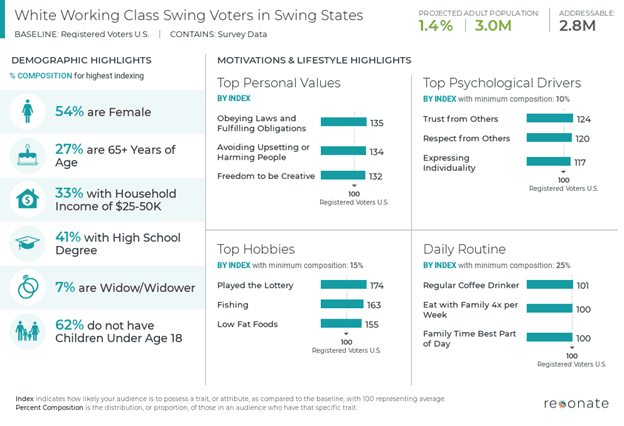Beltway media and other political pros say neither candidate won Tuesday night’s debate. Maybe that’s true. Trump’s all-out rebellion against the rules didn’t bleed his base. Right-wing memes were quick to depict the president as herculean in a standoff against both Wallace and Biden.
As for Biden, viewers who wanted a sleepy caricature of a candidate would have been disappointed. Biden was prepared, focused and engaging, putting to rest recent rumblings in the base regarding their leader’s energy levels.
It’s Not About Who Won, It’s About Who Connected
However, for up-and-down ballot campaigns in tight battles, debates like Tuesday night are not just about the base. It is the persuadables that these campaigns need to be keenly focused on.
At the top of the ticket, the persuadables in swing states that dictate the Electoral College are the Holy Grail. So ask yourself, which candidate best connected with these audiences? Let’s see what the data has to say.
Connecting with Powerful Persuadables
At Resonate, our online behavior models are tracking the motivations, policies and candidate attributes that are actually capable of persuading national and local niche voter audiences that hold the power to decide the closest races.
Based on Tuesday night’s debate, we wanted to see what the online data say about how the candidates would have connected – based on their performances – with white working-class adults who self-identify as swing voters in pivotal states (MI, OH, PA, WI, NH, NV, FL).

Rust Belt states comprise the majority of the states we looked at for this exercise. While the Black Lives Matter movement has dominated the headlines this year, the battle for White working-class voters in the Rust Belt and beyond remains critical in this race.
White working-class voters helped carry Trump to Pennsylvania Avenue in 2016 when Trump took Michigan, Pennsylvania and Wisconsin – the first Republican to do so since Ronald Reagan.
Amongst many other attributes, Biden finds himself at the top of the ticket because of his ability to win this pivotal audience in pivotal states. In fact, Amtrak Joe boarded a Rust Belt-bound Amtrak the day after the debate, making stops to see these voters in-person.
What Does the Data Say?
On Values and Drivers
Our online behavior models immediately flagged that these White working-class swing voters value obeying the laws, following the rules and avoiding upsetting others (about 35% more than your average voter).
If you reflect back on Trump’s antics on Tuesday night, perhaps they were not tailored to the values of this audience. At a minimum, the data show that these voters were likely uncomfortable with the whole thing.
We also see that this audience is driven by respect from others. In any regard, these voters would not have appreciated the insults coming from either side of the stage.
On the Issues
Trump’s boasting of putting conservative justices on the courts was a smart play with this group.
This audience, when compared to the average voter, is 29% more likely to support and agree with Trump’s approach to confirming conservative judges. With the SCOTUS vacancy now a major part of elections at all levels, Republican campaigns would be wise to incorporate this messaging when addressing this audience.
On the issue of police reform, this audience is more pro-law enforcement than your average voter and they’re 16% more likely to support strengthening laws and prosecution of crimes. They’re also less likely to believe that police treatment of Black Americans is a major election issue.
Trump was smart to hammer on the endorsements his campaign is receiving from the law enforcement community, however, Biden did a nice job striking a balanced tone when he explained the basics of “reimagining policing” and publicly stated his support for the majority in blue.
On healthcare, our persuadable white working-class audience demonstrates behavior that largely supports Obamacare. In fact, compared to your average voter, they are 57% more likely to oppose repealing the law. Biden and down-ballot Democrats should continue to emphasize Obamacare’s role in providing healthcare to those who would otherwise be uninsured – it’s a winning message with this group.
However, Trump would have resonated with these voters when he played up his efforts to combat Big Pharma and lower prescription drug prices. This audience, compared to the average voter, is 50% more likely to struggle to pay for prescription drugs, demonstrating the power this line has for Republican candidates.
On Candidate Traits
An out-of-touch candidate does not work for White working-class swing voters. This audience, compared to your average voter, is 40% more likely to vote against a candidate they view as tone-deaf.
Biden’s strategy to paint Trump as a tax-dodging politician who doesn’t care about the little guy was tailor-made for these voters. His “walk a mile in my shoes” messaging takes dead aim at their hearts and minds. While Trump largely talked to Biden, Biden made a point to look at the camera and speak to the voters. This likely paid dividends with this audience.
For Trump, crystalizing how his deal-making has directly supported the American worker will need to remain a staple in his debate and messaging strategy, whether it is drilling down on his decision to exit the Paris Accord (this audience is 54% more likely to believe that climate change is caused by natural causes) or renegotiating free trade deals to put blue-collar jobs first.
Ready to target and win this unique voter segment? Request a demo or contact us or by phone at 855-855-4320.



